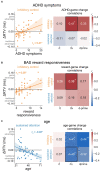Influence of game features on attention in adults
- PMID: 37228349
- PMCID: PMC10203248
- DOI: 10.3389/fpsyg.2023.1123306
Influence of game features on attention in adults
Abstract
Introduction: The incorporation of game features into cognitive tasks can inform us about the influence of reward and motivation on attention. Continuous performance tasks (CPTs), designed to assess attention abilities, are examples of cognitive tasks that have been targeted for the addition of game features. However, previous results have been mixed regarding how game elements affect attention abilities and task performance.
Methods: Here, we studied if there were factors that predict which individuals exhibit changes in attention from game features added to a CPT. Participants (N = 94, aged 21-71) played a traditional CPT and a game CPT with identical mechanics, but featured engaging game elements (aesthetics, storyline, competition, feedback, and reward).
Results: We first found corroborating evidence that game features have mixed effects on attention performance: most attention metrics of interest exhibited no overall difference between the traditional and game CPT, while game elements reduced performance for a few metrics. Importantly, we also found that specific behavioral and demographic profiles predicted individual differences in performance on the game CPT compared to the traditional CPT. Those with more attention difficulties (ADHD symptoms), more reward responsiveness, and younger adults performed better on the game CPT while, conversely, those with fewer ADHD symptoms, less reward responsiveness, and older adults performed better on the traditional CPT.
Discussion: These findings provide insights into how game features can influence attention in different individuals and have important implications for the use of game elements in cognitive tasks and training interventions.
Keywords: ADHD symptoms; attention; continuous performance task; game features; reward responsiveness.
Copyright © 2023 Gallen, Schachtner, Anguera-Singla, Anguera and Gazzaley.
Conflict of interest statement
The authors declare that the research was conducted in the absence of any commercial or financial relationships that could be construed as a potential conflict of interest.
Figures




References
-
- Adams M. G. (2009). Engaging 21st-century adolescents: video games in the reading classroom. English J. 98, 56–69.
-
- Anguera J. A., Gazzaley A. (2015). Video games, cognitive exercises, and the enhancement of cognitive abilities. Curr. Opin. Behav. Sci. 4, 160–165. doi: 10.1016/j.cobeha.2015.06.002 - DOI

